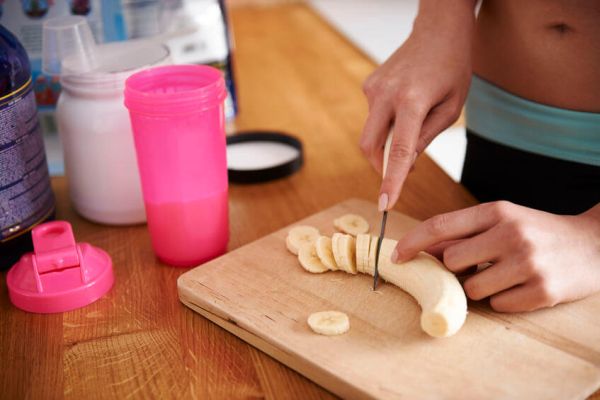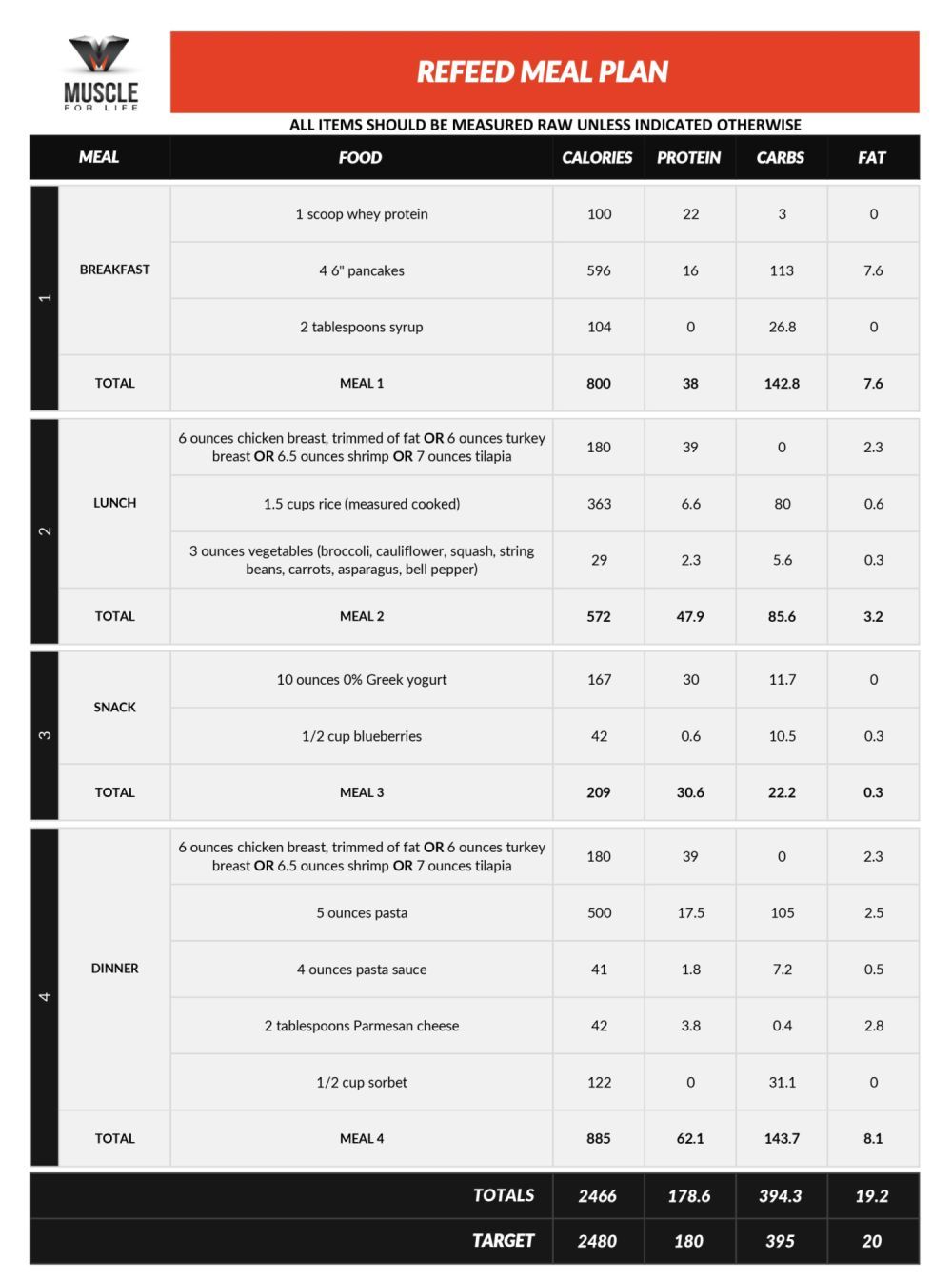For most, the beginning of a diet is an exciting moment, teeming with optimism and ecstasy.
For the first couple of months, it’s usually smooth sailing: you exercise regularly and maintain a proper calorie deficit and your body fat percentage progressively declines.
Eventually, though, progress slows. Your energy in the gym wanes and your workouts get harder and harder. Your goal, which seemed in the bag just a month ago, now appears further and further away.
And if you’re like most people, this is where you lose heart and binge. And then binge again. And again.
But there’s hope. And it doesn’t involve dropping your calorie intake to dangerously low levels or frying your muscles with excessive cardio.
Instead, the “trick” is something you’ll relish: occasional overfeeding.
Yes, that’s right–eating a bunch of food. Not just anything and everything, though–there’s more to it than that. This weight loss aid is known as “refeeding,” and here’s how it works…
Table of Contents
+Want to listen to more stuff like this? Check out my podcast!
What is Refeeding?
Refeeding is generally defined as a planned increase in calorie intake that typically occurs when dieting. Refeeding can yield a myriad of psychological and physiological benefits:
- Decreased risk for binge eating via hunger regulation
- Increased motivation from boosted testosterone, dopamine (a hormone responsible for reward and pleasure), and leptin (a hormone responsible for satiety and metabolism).
The most powerful of these effects is one that most people aren’t familiar with. It relates to leptin, which regulates hunger, your metabolic rate, appetite, motivation, and libido, as well as serving other functions in your body.
When you’re in a caloric deficit and lose body fat, your leptin levels drop. This, in turn, causes your metabolic rate to slow down, your appetite to increase, your motivation to wane, and your mood to sour.
On the other hand, when you give your body more energy (calories) than it needs, leptin levels are boosted, which can then have positive effects on fat oxidation, thyroid activity, mood, and even testosterone levels.
The net effect of a proper refeed is you feel better both physically and psychologically, you’re much less likely to fall down the slippery slope of “just one more cheat day,” and you can even experience a nice acceleration of fat loss over the following 3 to 5 days.
Nonetheless, the caveat to this is that it requires self-control.
If you abuse these periods of overfeeding then you will simply gain too much fat as a result to make them effective weight loss aids. Research has shown that an all-out binge can increase your metabolism by three to 10% for merely 24 hours, but the sheer amount of calories eaten will negate this negligible increase in metabolism, making the aching-after effects of a typical binge not worth it.
Fortunately, you are about to learn how to avoid these problems by strategically devising a refeed day relative to your unique metabolic makeup.
How to Set Up a Refeed Day

First, you should determine how frequently you need a refeed day.
If you are fairly lean or in the deeper phases of dieting, you are more susceptible to metabolic adaptation and mental lethargy. By cutting calories, you expend less energy, chiefly because you move less—this is referred to as adaptive thermogenesis. Thus, begin with one refeed day a week and adjust as needed.
However, if you are in the early periods of dieting are still above 10% body fat (guys) or 20% (girls), start with one refeed day every 2 weeks and see how your body responds.
After determining how often you should reefed, it is vital to set a caloric goal for each refeed.
Us humans are innately horrible at estimating our caloric intake. We are not programmed to do so. To exacerbate the matter, we are biologically prone to eating large amounts when food is available, specifically foods high in energy:
“Because of the scarcity and unpredictability of food in nature, humans and other animals have evolved to eat their physiological limits when food is readily available, so that excess energy can be stored in the body as a buffer against future food shortages.” –Pinel JPJ.
Thus, a form of energy regulation will keep you from overindulging and help you attain the benefits associated with a refeed day.
To do this, take your current daily calorie intake and increase it by 30%. This will provide enough of a surplus to confer the benefits of refeeding without adding too much body fat.
Next, break the calories into the following macronutrient profile:
- 0.8 grams of protein per pound of body weight
- As little dietary fat as possible (most recommendations are stay at or under 40 grams)
- The rest from carbohydrate
Why so many carbs, you wonder? Because eating carbohydrates is the most effective way to increase leptin levels. Second to that is eating protein (high-protein meals also raise your metabolic rate). Dietary fats aren’t very effective at increasing leptin levels, and alcohol actually inhibits it.
Eating a bunch of carbs has further benefits that relate to glycogen, which is a stored form of glucose responsible for fueling your workouts.
While dieting, your glycogen stores progressively decline and with them your strength and muscle endurance. Acutely increasing carbohydrate intake is an easy way to fill them back up and thus improve your performance in the gym.
Refeed Meal Plans
If you’re wondering how exactly how to go about planning a refeed day, here’s an example of a refeed meal plan we’ve made for our custom meal plan clients.

As you can see, it’s pretty simple.
You stick to low-fat sources of protein like lean meat, low-fat dairy, protein powder, egg whites, etc., and eat a variety of carbs with an emphasis (usually) on whole grains because of their caloric density.
The Bottom Line on Refeeding

The refeed day is an effective way to stay on track in your dieting, avoiding the dreaded binge, and even accelerate fat loss.
I hope that this article has granted you ideas for how to incorporate refeed days in your nutritional regimens while dieting, and how to structure them for your unique psychological and physiological disposition.
If you’re not using refeed days by now—or not strategically manipulating them—now is the time to start. Perhaps you will be amazed by just how useful a refeed day can be.
What do you think about the refeed day? Have anything else to share? Let me know in the comments below!
Scientific References +
- Kreitzman SN, Coxon AY, Szaz KF. Glycogen storage: illusions of easy weight loss, excessive weight regain, and distortions in estimates of body composition. Am J Clin Nutr. 1992;56(1 Suppl):292S-293S. doi:10.1093/ajcn/56.1.292S
- Brooks GA, Mercier J. Balance of carbohydrate and lipid utilization during exercise: The “crossover” concept. J Appl Physiol. 1994;76(6):2253-2261. doi:10.1152/jappl.1994.76.6.2253
- Röjdmark S, Calissendorff J, Brismar K. Alcohol ingestion decreases both diurnal and nocturnal secretion of leptin in healthy individuals. Clin Endocrinol (Oxf). 2001;55(5):639-647. doi:10.1046/j.1365-2265.2001.01401.x
- Bray GA, Smith SR, Rood J, et al. on Weight Gain , Energy Expenditure. Biomed Res. 2012;307:47-55. doi:10.1001/jama.2011.1918
- Dirlewanger M, Di Vetta V, Guenat E, et al. Effects of short-term carbohydrate or fat overfeeding on energy expenditure and plasma leptin concentrations in healthy female subjects. Int J Obes. 2000;24(11):1413-1418. doi:10.1038/sj.ijo.0801395
- Tooze JA, Vitolins MZ, Smith SL, et al. High Levels of Low Energy Reporting on 24-Hour Recalls and Three Questionnaires in an Elderly Low-Socioeconomic Status Population. J Nutr. 2007;137(5):1286-1293. doi:10.1093/jn/137.5.1286
- Pinel JP, Assanand S, Lehman DR. Hunger, eating, and ill health. Am Psychol. 2000;55(10):1105-1116. doi:10.1037//0003-066x.55.10.1105
- Dulloo AG, Jacquet J, Montani J-P, Schutz Y. Adaptive thermogenesis in human body weight regulation: more of a concept than a measurable entity? Obes Rev. 2012;13 Suppl 2:105-121. doi:10.1111/j.1467-789X.2012.01041.x
- Katzeff HL, O’Connell M, Horton ES, Danforth E, Young JB, Landsberg L. Metabolic studies in human obesity during overnutrition and undernutrition: thermogenic and hormonal responses to norepinephrine. Metabolism. 1986;35(2):166-175. doi:10.1016/0026-0495(86)90119-8
- Ceddia RB. Direct metabolic regulation in skeletal muscle and fat tissue by leptin: Implications for glucose and fatty acids homeostasis. Int J Obes. 2005;29(10):1175-1183. doi:10.1038/sj.ijo.0803025
- JÉQUIER E. Leptin Signaling, Adiposity, and Energy Balance. Ann N Y Acad Sci. 2006;967(1):379-388. doi:10.1111/j.1749-6632.2002.tb04293.x
- Hausman GJ, Barb CR. Adipose tissue and the reproductive axis: biological aspects. Endocr Dev. 2010;19:31-44. doi:10.1159/000316895
- Davis JF. Adipostatic regulation of motivation and emotion. Discov Med. 2010;9(48):462-467. http://www.ncbi.nlm.nih.gov/pubmed/20515615. Accessed November 5, 2019.
- Davis JF, Choi DL, Benoit SC. Insulin, leptin and reward. Trends Endocrinol Metab. 2010;21(2):68-74. doi:10.1016/j.tem.2009.08.004
- Pratley RE, Nicolson M, Bogardus C, Ravussin E. Plasma leptin responses to fasting in Pima Indians. Am J Physiol. 1997;273(3 Pt 1):E644-9. doi:10.1152/ajpendo.1997.273.3.E644
- Volkow ND, Wang G-J, Baler RD. Reward, dopamine and the control of food intake: implications for obesity. Trends Cogn Sci. 2011;15(1):37-46. doi:10.1016/j.tics.2010.11.001
- Forbes GB, Brown MR, Welle SL, Underwood LE. Hormonal response to overfeeding. Am J Clin Nutr. 1989;49(4):608-611. doi:10.1093/ajcn/49.4.608










